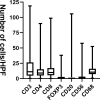Clinical and Prognostic Significance of Tumor-Infiltrating CD8+ T Cells and PD-L1 Expression in Primary Gastrointestinal Stromal Tumors
- PMID: 34956906
- PMCID: PMC8709532
- DOI: 10.3389/fonc.2021.789915
Clinical and Prognostic Significance of Tumor-Infiltrating CD8+ T Cells and PD-L1 Expression in Primary Gastrointestinal Stromal Tumors
Abstract
Purpose: Immunotherapy for gastrointestinal stromal tumors (GISTs) remains a clinical challenge. The present study aimed to explore the clinical and prognostic significance of immune cell infiltration and PD-L1 expression in GISTs.
Methods: A total of 507 clinical tissue specimens of primary GISTs were collected for immunohistochemical analysis of immune cell infiltration and PD-L1 expression. Influencing factors of survival were evaluated by Kaplan-Meier analysis. Univariate and multivariate analyses were performed using the Cox regression model.
Results: There were significant differences in sex, tumor location, size, mitotic index, NIH risk grade, and cell morphology between different gene mutation types of GISTs. Immune cell infiltration in GISTs mainly involved macrophages and T cells. PD-1 was expressed in 48.5% of the tissue specimens, and PD-L1 expression was detected in 46.0% of the samples. PD-L1 expression was negatively correlated with the tumor size and mitotic index but positively correlated with the number of CD8+ T cells. There were significant differences in the number of CD8+ T cells between different gene mutation types. Wild type-mutant GISTs were enriched with CD8+ T cells as compared with KIT- and PDGFRA-mutant GISTs. The number of CD8+ T cells was higher in non-gastric GISTs. PD-L1 and CD8+ T cells were independent predictors for better relapse-free survival of GISTs.
Conclusions: PD-L1 expression is a predictive biomarker for better prognosis of GISTs. Non-gastric GIST patients with wild-type mutations may be the beneficiaries of PD-1/PD-L1 inhibitors.
Keywords: PD-L1; gastrointestinal stromal tumors; prognosis; programmed cell death protein-1; programmed cell death protein-Ligand 1; tumor-infiltrating lymphocyte.
Copyright © 2021 Sun, Shu, Fang, Yuan, Zhang, Sun, Fu, Xue, Gao, Shen, Hou, Sun, Qin and Qin.
Conflict of interest statement
The authors declare that the research was conducted in the absence of any commercial or financial relationships that could be construed as a potential conflict of interest.
Figures



Similar articles
-
Immune Cell Infiltration and the Expression of PD-1 and PD-L1 in Primary PDGFRA-Mutant Gastrointestinal Stromal Tumors.J Gastrointest Surg. 2021 Aug;25(8):2091-2100. doi: 10.1007/s11605-020-04860-8. Epub 2020 Nov 9. J Gastrointest Surg. 2021. PMID: 33169322
-
Combined Positive Score for Programmed Death Ligand-1 Expression and Inflammatory Microenvironment in Gastrointestinal Stromal Tumors.Medicina (Kaunas). 2022 Jan 24;58(2):174. doi: 10.3390/medicina58020174. Medicina (Kaunas). 2022. PMID: 35208498 Free PMC article.
-
PD-1/PD-L1 Blockade Enhances T-cell Activity and Antitumor Efficacy of Imatinib in Gastrointestinal Stromal Tumors.Clin Cancer Res. 2017 Jan 15;23(2):454-465. doi: 10.1158/1078-0432.CCR-16-1163. Epub 2016 Jul 28. Clin Cancer Res. 2017. PMID: 27470968 Free PMC article.
-
A Systematic Review of the Tumor-Infiltrating CD8+ T-Cells/PD-L1 Axis in High-Grade Glial Tumors: Toward Personalized Immuno-Oncology.Front Immunol. 2021 Sep 17;12:734956. doi: 10.3389/fimmu.2021.734956. eCollection 2021. Front Immunol. 2021. PMID: 34603316 Free PMC article.
-
Gastrointestinal stromal tumors: review on morphology, molecular pathology, prognosis, and differential diagnosis.Arch Pathol Lab Med. 2006 Oct;130(10):1466-78. doi: 10.5858/2006-130-1466-GSTROM. Arch Pathol Lab Med. 2006. PMID: 17090188 Review.
Cited by
-
Prognostic and clinicopathological significance of the Prognostic Nutritional Index in patients with gastrointestinal stromal tumours undergoing surgery: a meta-analysis.BMJ Open. 2022 Dec 1;12(12):e064577. doi: 10.1136/bmjopen-2022-064577. BMJ Open. 2022. PMID: 36456008 Free PMC article.
-
Unexpected reaction of "wild-type" gastrointestinal stromal tumor to imatinib: case report and literature review.Front Oncol. 2024 Jan 31;13:1334784. doi: 10.3389/fonc.2023.1334784. eCollection 2023. Front Oncol. 2024. PMID: 38357425 Free PMC article.
-
The Prognostic Value of Plasma Programmed Death Protein-1 (PD-1) and Programmed Death-Ligand 1 (PD-L1) in Patients with Gastrointestinal Stromal Tumor.Cancers (Basel). 2022 Nov 23;14(23):5753. doi: 10.3390/cancers14235753. Cancers (Basel). 2022. PMID: 36497235 Free PMC article.
-
Construction and validation of a prognostic model for gastrointestinal stromal tumors based on copy number alterations and clinicopathological characteristics.Front Oncol. 2022 Dec 21;12:1055174. doi: 10.3389/fonc.2022.1055174. eCollection 2022. Front Oncol. 2022. PMID: 36620561 Free PMC article.
-
New insight on the correlation of immune landscapes with immune markers expression in different risk classification of gastrointestinal stromal tumors.J Gastroenterol. 2023 Jun;58(6):527-539. doi: 10.1007/s00535-023-01981-0. Epub 2023 Mar 24. J Gastroenterol. 2023. PMID: 36961557
References
LinkOut - more resources
Full Text Sources
Research Materials
Miscellaneous

